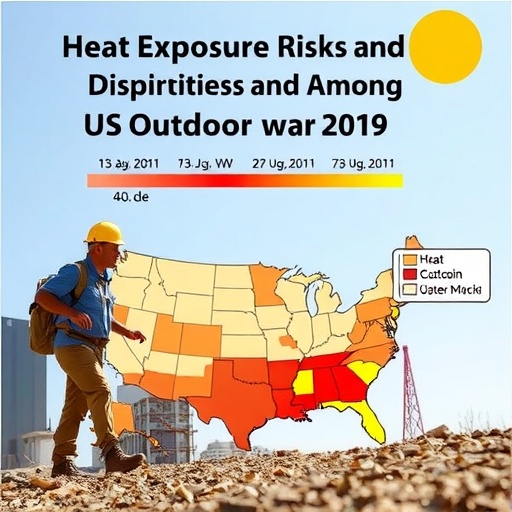As global temperatures continue to rise, the impact of occupational heat exposure on outdoor workers has become an increasingly urgent public health concern. A recent study published in the Journal of Exposure Science and Environmental Epidemiology offers a comprehensive analysis of occupational heat exposure incidence across the United States from 2010 to 2019, revealing significant sociodemographic disparities among outdoor laborers. This research sheds light on how heat-related occupational hazards are distributed across different worker populations and provides critical insights into the intersection of environmental stressors and social inequities.
Outdoor workers, including those in construction, agriculture, landscaping, and other physically demanding sectors, face prolonged exposure to high temperatures, which can lead to heat stress, heat exhaustion, and even heat stroke. With climate change accelerating the frequency and intensity of heatwaves, understanding the patterns and drivers of heat exposure among these vulnerable groups is vital for crafting effective preventative policies and safeguarding worker health. The study’s longitudinal approach examines nearly a decade of data, offering a rare opportunity to track changes in heat exposure risks over time.
Utilizing a robust dataset combining meteorological heat indices and occupational incidence reports, the researchers quantified the incidence rates of heat exposure events among outdoor workers across diverse geographic regions. Their methodology integrated heat index values—an indicator combining temperature and humidity—to assess environmental heat stress more accurately, rather than relying on temperature alone. This nuanced approach allows for a more precise identification of periods and locations where workers face the highest heat-related risks.
One of the study’s key findings is the disproportionate burden borne by workers in the Southern and Western United States, where climatic conditions frequently cross thresholds known to pose severe heat hazards. These regions witnessed higher incidence rates of heat exposure cases, correlating strongly with local heat index intensities. The spatial variability underscores the need for region-specific intervention strategies. Policies responsive to local climate realities rather than generic nationwide mandates will be crucial in addressing occupational heat risks effectively.
Beyond geography, the study highlights profound sociodemographic disparities. Outdoor workers from racial and ethnic minority backgrounds, particularly Hispanic and Black populations, experienced higher incidences of heat exposure. These disparities are attributed in part to occupational segregation, where minority workers disproportionately occupy high-risk, labor-intensive roles with less access to protective measures. Limited economic resources and social support may compound their vulnerability, impeding access to adequate hydration, rest breaks, and cooling infrastructure.
Age emerged as another critical determinant, with younger workers showing elevated risks of occupational heat exposure. This may reflect a combination of factors such as greater involvement in physically demanding outdoor tasks, less experience recognizing heat-related symptoms, and limited negotiating power to demand safer working conditions. The study’s findings call for targeted educational programs and safety protocols tailored to younger laborers entering heat-exposed occupations.
Furthermore, the incidence data revealed temporal trends suggestive of increasing heat exposure risks over the decade examined. The upward trajectory coincides with documented temperature increases and more frequent heat waves, a phenomenon that climate scientists have linked closely to anthropogenic climate change. This temporal association not only validates concerns about the tangible effects of warming climates on worker health but also motivates immediate adaptation measures to curtail future risk escalations.
Employers and policymakers are thus faced with the daunting challenge of mitigating occupational heat exposures amidst a warming planet. The study underscores strategies including the implementation of heat illness prevention programs, mandatory heat acclimatization schedules, provision of personal protective equipment designed for hot environments, and investment in shaded rest areas. Regulatory frameworks may need revision to enforce maximum allowable heat exposure thresholds and ensure compliance with safety standards.
Critically, the research team emphasizes the importance of considering equity in heat risk management. Without deliberate efforts to address the social determinants underpinning the observed disparities, interventions may fail to reach or adequately protect the most vulnerable worker groups. Inclusive policymaking that incorporates worker voices, prioritizes equity-focused resource allocation, and integrates culturally competent communication can enhance the effectiveness and fairness of heat mitigation efforts.
The study also advocates for enhanced surveillance and data collection methods to better monitor heat exposure incidents. Current occupational health reporting systems often undercount heat-related illnesses, particularly among marginalized populations who may lack access to healthcare or fear job loss from reporting symptoms. Expanding surveillance infrastructure can improve risk assessments and drive evidence-based responses.
Moreover, advances in wearable technology and environmental sensors offer promising tools for real-time monitoring of worker heat exposure and physiological stress indicators. Integrating such technologies into workplace safety protocols can facilitate early detection of heat stress, enabling timely interventions and reducing heat illness incidence. The study calls for interdisciplinary collaborations to develop and deploy these innovative solutions efficiently.
Education and training also play a pivotal role. Raising awareness among workers and supervisors about the signs and dangers of heat stress, as well as safe work practices under extreme heat conditions, can empower frontline communities to advocate for and maintain safer work environments. Tailored curricula that respect linguistic and cultural diversity will be more effective in reaching diverse labor populations.
The economic implications of rising occupational heat exposure cannot be understated. Beyond the direct health impacts on workers, heat-related illnesses result in lost productivity, increased medical costs, and potential legal liabilities for employers. By quantifying the incidence and highlighting vulnerable groups, the study provides vital data that can support cost-benefit analyses for investing in preventive measures, ultimately protecting both worker well-being and economic interests.
As climate projections forecast worsening heat scenarios, this research serves as a clarion call for urgent action within occupational health frameworks. The intersection of environmental stressors and social inequities demands holistic strategies encompassing climate adaptation, public health, labor rights, and social justice. Without systemic interventions, outdoor workers will continue to face escalating dangers linked to heat exposure, exacerbating existing disparities and threatening the sustainability of outdoor labor sectors.
In conclusion, this study offers a critical evidence base revealing the magnitude and nuances of occupational heat exposure risks in the United States. By illuminating regional, racial, ethnic, and age-related disparities, it charts a path toward more informed, equitable, and effective responses to a pressing climate and public health challenge. Policymakers, employers, researchers, and worker advocates must heed these findings to forge resilient workplaces and safeguard the health of America’s outdoor workforce in an increasingly hot world.
Subject of Research: Occupational heat exposure incidence and sociodemographic disparities among outdoor workers in the United States from 2010 to 2019.
Article Title: Occupational heat exposure incidence and sociodemographic disparities for outdoor workers in the United States, 2010–2019.
Article References:
Shkembi, A., Payne-Sturges, D., Park, S.K. et al. Occupational heat exposure incidence and sociodemographic disparities for outdoor workers in the United States, 2010–2019. J Expo Sci Environ Epidemiol (2025). https://doi.org/10.1038/s41370-025-00813-y
DOI: https://doi.org/10.1038/s41370-025-00813-y
Tags: agricultural workers and heat exposureclimate change impact on laboreffective policies for worker health protectionenvironmental stressors and social inequitiesheat stress prevention strategiesheat-related illnesses in construction workerslongitudinal study on heat hazardsoccupational heat exposureoccupational safety in extreme temperaturesoutdoor worker health riskssociodemographic disparities in heat exposurevulnerable worker populations





